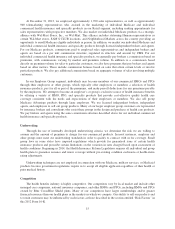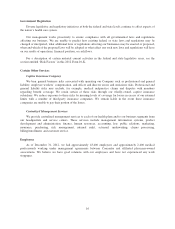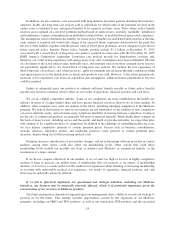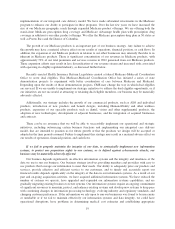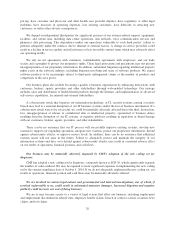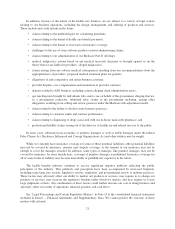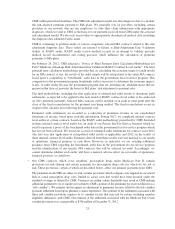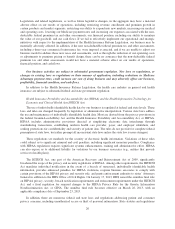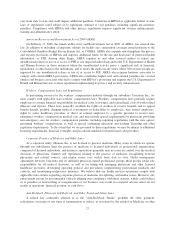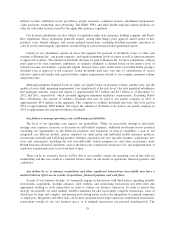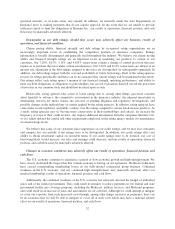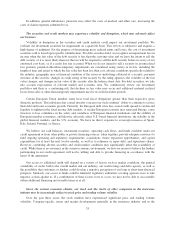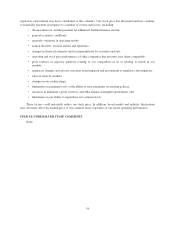Humana 2012 Annual Report Download - page 35
Download and view the complete annual report
Please find page 35 of the 2012 Humana annual report below. You can navigate through the pages in the report by either clicking on the pages listed below, or by using the keyword search tool below to find specific information within the annual report.Recently enacted health insurance reform, including The Patient Protection and Affordable Care Act and
The Health Care and Education Reconciliation Act of 2010, could have a material adverse effect on our
results of operations, including restricting revenue, enrollment and premium growth in certain products and
market segments, restricting our ability to expand into new markets, increasing our medical and operating
costs by, among other things, requiring a minimum benefit ratio on insured products (and particularly how
the ratio may apply to Medicare plans), lowering our Medicare payment rates and increasing our expenses
associated with a non-deductible federal premium tax and other assessments; financial position, including our
ability to maintain the value of our goodwill; and cash flows. In addition, if the new non-deductible federal
premium tax and other assessments, including a three-year commercial reinsurance fee, were imposed as
enacted, and if we are unable to adjust our business model to address these new taxes and assessments, such
as through the reduction of our operating costs or adjustments to premium pricing or benefit design, there can
be no assurance that the non-deductible federal premium tax and other assessments would not have a material
adverse effect on our results of operations, financial position, and cash flows.
In March 2010, the President signed into law The Patient Protection and Affordable Care Act and The
Health Care and Education Reconciliation Act of 2010 (which we collectively refer to as the Health Insurance
Reform Legislation) which enact significant reforms to various aspects of the U.S. health insurance industry.
While regulations and interpretive guidance on some provisions of the Health Insurance Reform Legislation have
been issued to date by the Department of Health and Human Services, or HHS, the Department of Labor, the
Treasury Department, and the National Association of Insurance Commissioners, there are many provisions of
the legislation that will require additional guidance and clarification in the form of regulations and interpretations
in order to fully understand the impacts of the legislation on our overall business, which we expect to occur over
the next several years.
The provisions of the Health Insurance Reform Legislation include, among others, imposing significant new
non-deductible federal premium taxes and other assessments on health insurers, limiting Medicare Advantage
payment rates, stipulating a prescribed minimum ratio for the amount of premiums revenue to be expended on
medical costs for insured products (and particularly how the ratio may apply to Medicare Advantage and
prescription drug plans), additional mandated benefits and guarantee issuance associated with commercial
medical insurance, requirements that limit the ability of health plans to vary premiums based on assessments of
underlying risk, and heightened scrutiny by state and federal regulators of our business practices, including our
Medicare bid and pricing practices. The Health Insurance Reform Legislation also specifies benefit design
guidelines, limits rating and pricing practices, encourages additional competition (including potential incentives
for new market entrants), establishes federally-facilitated or state-based exchanges for individuals and small
employers (with up to 100 employees) coupled with programs designed to spread risk among insurers, and
expands eligibility for Medicaid programs. In addition, the law will increase federal oversight of health plan
premium rates and could adversely affect our ability to appropriately adjust health plan premiums on a timely
basis. Financing for these reforms will come, in part, from material additional fees and taxes on us and other
health plans and individuals beginning in 2014, as well as reductions in certain levels of payments to us and other
health plans under Medicare. Implementation dates of the provisions of the Health Insurance Reform Legislation
began in September 2010 and continue through 2018.
Implementing regulations and related interpretive guidance continue to be issued on several significant
provisions of the Health Insurance Reform Legislation. Congress may also withhold the funding necessary to
implement the Health Insurance Reform Legislation, or may attempt to replace the legislation with amended
provisions. Given the breadth of possible changes and the uncertainties of interpretation, implementation, and
timing of these changes, which we expect to occur over the next several years, the Health Insurance Reform
Legislation will change the way we do business, potentially impacting our pricing, benefit design, product mix,
geographic mix, and distribution channels. In particular, implementing regulations and related guidance are
forthcoming on various aspects of the minimum benefit ratio requirement’s applicability to Medicare, including
aggregation, credibility thresholds, and its application to prescription drug plans. The response of other
companies to Health Insurance Reform Legislation and adjustments to their offerings, if any, could cause
meaningful disruption in the local health care markets. It is reasonably possible that the Health Insurance Reform
25


